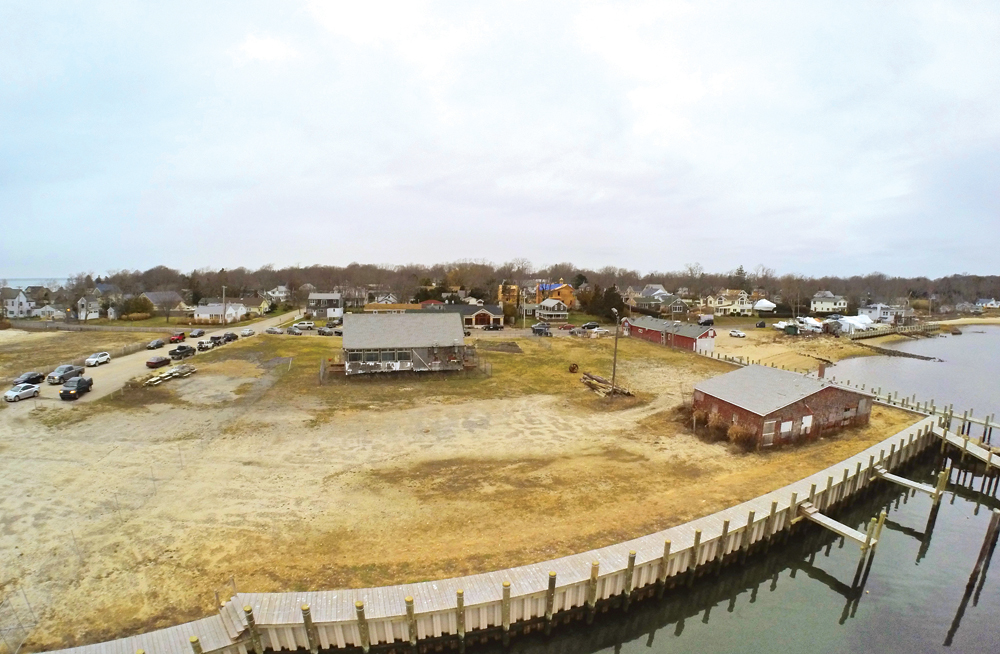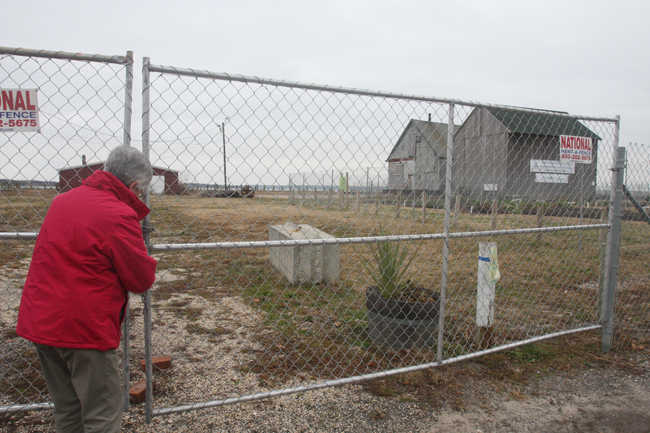A look back at the Galley Ho’s remarkable history

Its location has changed at least four times in less than a century, but one thing pretty much has stayed the same. Throughout its history, the building that’s become known locally as the Galley Ho has served the North Fork food industry in some capacity.
At least, when it wasn’t vacant, as it is today.
From the 1940s into the 21st century, it was a place where locals and visitors to New Suffolk could snack on seafood and have a drink. From the 19th century until before World War II, the simple rectangular structure was involved in the wholesale side of the food business — specifically, making oyster barrels.
Despite its age and precarious location near the water, it managed to survive the Hurricane of 1938, the Perfect Storm and, most recently, Superstorm Sandy, among other weather events.
The building’s current owner, the nonprofit New Suffolk Waterfront Fund, will soon break ground on a project designed to reclaim its history by rebuilding it as a restaurant and lifting it to ensure that it survives the many storms yet to come.
In light of the impending construction — and a very public battle this year between locals over the redevelopment plan — The Suffolk Times set out to document the rich history of this unassuming yet remarkable building.
THE OLD COOPERAGE
Reports on the age of the Galley Ho vary, but it’s believed to have been built in the late 1800s, at the height of New Suffolk’s booming oyster industry, said Cutchogue-New Suffolk Library historian Mariella Ostroski, who helped the newspaper compile a timeline for the building.
Initially owned by the Radell Oyster Company, it was used to manufacture oyster barrels in which to ship the bounty of shellfish that was raked in from Cutchogue Harbor — a purpose it served for several decades. The structure originally stood at the intersection of Jackson and Second streets, about a block and a half south and one block west of its location today. It remained there as a working industrial building into the 1940s, when the oyster and fishing industry in New Suffolk petered out and there was no longer demand for such a cooperage. But the structure persisted.
A PLACE TO EAT
The building got its start as an eatery in the early 1940s, when Charlie Dompke purchased the barrel-making facility and transformed it into Dompke’s restaurant. Described as a luncheonette, Dompke’s was popular among New Suffolk fishermen, Ms. Ostroski said.
In 1943, Elsie Fench of New Suffolk purchased the building and moved it closer to her home, near what is now the southwest corner of First and Jackson streets, at New Suffolk Town Beach. Her bayfront diner was called Fench’s, but was known affectionately among locals as the Coney Island Building, or simply Coney Island. It wasn’t until 1963 that Southold Town acquired land and Ms. Fench sold the building to Commander Arthur Kenniff, who already owned the 3.4-acre North Fork Shipyard property to the north. He moved the building to his First Street shipyard, across from what’s now Legends Restaurant. That’s where the structure sits today, although it was shifted about 100 feet closer to First Street after Superstorm Sandy.
The waterfront property surrounding the building today has its own interesting history. Until the 1980s it was the site of the North Fork Shipyard, but from 1897 to 1905 it served as the port where The Holland Torpedo Company conducted trials of the U.S. Navy’s first modern commissioned submarine, the USS Holland.
The building became the Galley Ho Restaurant in April 1974, when Dean Blaikie, then just 23, began renting the space from Cmdr. Kenniff. Mr. Blaikie renovated the building’s interior, adding a modern kitchen and a fireplace that allowed the restaurant to be open year round for the first time, according to an article in The Tides, a now-defunct publication that served only New Suffolk.
A 1983 advertisement in The Suffolk Times touted the Galley Ho’s fresh seafood dinners of mussels, lobster, clams, oysters and soft-shell crab.
“It was quite a popular place to hang out,” recalled Ms. Ostroski. “Everyone knew it was the spot to be.”

DEVELOPMENT PLANS
In 1985, New Suffolk caught the attention of developer Richard Carr, owner of Shamrock Properties in New York City, who purchased the 3.4-acre waterfront property. He then caused a stir by proposing a complex that would include condominiums, a restaurant, retail shops and a 137-slip marina. The idea met with heavy opposition from the community, namely the New Suffolk Civic Association, who wanted the land to remain undeveloped.
Mr. Blaikie continued to operate the Galley Ho after Mr. Carr bought the property, but closed the restaurant with little warning in 1988. In a Suffolk Times article published Feb. 18, 1988, he offered no explanation for his decision, although it was speculated that it was linked to Mr. Carr’s plan to overhaul the property.
In the article, Mr. Carr said he planned to reopen the restaurant under the same name, but Ms. Ostroski said the businesses that later occupied the space were neither successful nor long-standing. The Galley Ho name, however, endured.
By 1994, a Connecticut bank foreclosed on the property and Mr. Carr’s plans were abandoned. In April 1994, according to a previous Suffolk Times article, it was sold at auction for $800,000 to Love Lane Acquisitions, headed by former Southold Town Planning Board chairman Henry Raynor.
Through the end of the 1990s, Love Lane Acquisitions attempted to construct more boat slips. But again, development plans encountered resistance from the community.
In March 2002, Dan Giannini and chef Jeff Baruch leased the building and opened Harpoon Harry’s at the former Galley Ho.
By 2003, however, they got into a dispute with Love Lane Acquisitions. Harpoon Harry’s later closed and the building has been vacant ever since.
PRESERVATION EFFORTS
Determined not to see the waterfront threatened by large-scale development such as proposed by Mr. Carr or Love Lane Acquisitions, members of the New Suffolk Civic Association resolved in 2005 to purchase the property. To jump-start that effort, they established a nonprofit organization, the New Suffolk Waterfront Fund Inc., said current fund chairman Pat McIntyre.
Lacking its own financial means, the waterfront fund teamed up with the Peconic Land Trust and a “bargain sale” was negotiated with Love Lane Acquisitions. The Land Trust bought the property for $2.4 million in 2007. Three years later, as planned, the waterfront fund purchased the property from the Trust, with the help of a $1.5 million loan from The Conservation Fund, a national preservation group, and donations from more than 500 individual donors.
In 2012, as part of a deal to pay off its $1.5 million mortgage, the waterfront fund agreed to sell the southernmost acre of the property to billionaire Louis Moore Bacon, owner of Robins Island. It also received a $400,000 grant from the state parks department, according to a June 2012 Suffolk Times article.
Conservation easements on the Bacon parcel guarantee its protection from development moving forward. The remaining 2.4 acres are under the waterfront fund’s control and, in addition to the Galley Ho building, contain a historic barn, a community garden and a portion of the beach on the south side of the site.
A NEW GALLEY HO
With its goal of conservation met, the waterfront fund embarked on its next challenge: restoring the Galley Ho building.
Renovation plans stalled in October 2012, however, when flooding caused by Superstorm Sandy badly damaged the building’s foundation. The fund also had to reconstruct the eastern and northern edges of the property’s bulkheading due to the storm. It then drew up plans to relocate the structure before renovating it.
The plan is to reopen the Galley Ho, which would total 1,725 square feet after a small addition, as a restaurant with up to 66 seats. The building, which currently stands on cribbing roughly 120 feet from the water, will also be moved farther from the shoreline, ultimately resting roughly 75 feet from the water’s edge.
Not everyone in the community, however, has embraced this plan. Frequent concerns have been raised by business owners, civic association members and Planning Board officials since the project was first discussed publicly in May.
After some tweaks, the Planning Board approved the waterfront fund’s proposal in November.
Despite the controversy, Ms. McIntyre said the hope is to pour a foundation for the improved Galley Ho as soon as possible.
“We can’t wait to get started,” she said. “We are hoping to begin by the end of the year.”

